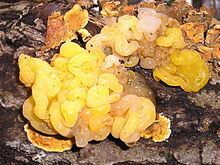Kingdom Fungi | Division Basidiomycota Scientific name Tremellaceae Rank Family | |
 | ||
Lower classifications | ||
Tremellaceae fungi kingdom
The Tremellaceae are a family of fungi in the order Tremellales. The family is cosmopolitan and contains both teleomorphic and anamorphic genera, most of the latter being yeasts. All teleomorphic species of fungi in the Tremellaceae are parasites of other fungi, though the yeast states are widespread and not restricted to hosts. Basidiocarps (fruit bodies), when produced, are gelatinous.
Contents
- Tremellaceae fungi kingdom
- History
- Current status
- Description of teleomorphs
- Habitat and distribution
- References
The family currently comprises 18 genera (plus synonyms), containing around 250 valid species. Significant genera include Tremella, two species of which are edible and commercially cultivated, and the yeast genus Cryptococcus, several species of which are human pathogens, causing cryptococcosis.
History
Fries created the family Tremellaceae (as 'Tremellini') in 1821, basing it on the macromorphology of fruit bodies. He included within it most species of fungi that were gelatinous, dividing it into the genera Agyrium, Dacrymyces, Exidia, Hymenella, Naematelia, and Tremella. Agyrium and Hymenella are now referred to the Ascomycota, as are several of the species Fries placed in Dacrymyces and Tremella.
In 1900 Patouillard radically revised the family by switching the emphasis to the micromorphology of fruit bodies. For Patouillard, the Tremellaceae was limited to genera and species in which the basidia were "tremelloid" (globose to ellipsoid with vertical or diagonal septa), whether or not the fruit bodies were gelatinous. Patouillard's revised Tremellaceae included the genera Clavariopsis (= Holtermannia), Ditangium, Exidia, Guepinia, Heterochaete, Hyaloria, Protomerulius, Sebacina, Sirobasidium, Tremella, and Tremellodon (= Pseudohydnum).
The next major revision was in 1984, when Bandoni used transmission electron microscopy to investigate the ultrastructure of the septal pore apparatus in species of the Tremellaceae. This revealed that Tremella and its allies were distinct from Exidia and its allies, despite both groups having tremelloid basidia. Bandoni referred the latter group to the Auriculariaceae, restricting the Tremellaceae to the genera Holtermannia, Tremella, and Trimorphomyces. The genus Sirobasidium and its allies were placed in the Sirobasidiaceae.
Current status
Molecular research, based on cladistic analysis of DNA sequences, confirms Bandoni's split between the tremelloid and exidioid fungi and extends the circumscription of the tremelloid group by including several yeast genera whose status was formerly uncertain. Molecular research has also indicated that the genus Filobasidiella (and its yeast state Cryptococcus) should be included within the group, even though its basidia are not tremelloid. The research does not, however, support a distinct family Tremellaceae within the order Tremellales, but instead divides the order (and indeed the genus Tremella) into several small clades. As currently circumscribed, the Tremellaceae is therefore an artificial subset of the Tremellales, not clearly distinct from the Sirobasidiaceae.
Description of teleomorphs
Many species of the Tremellaceae occur in the hymenium of their hosts and do not produce visible fruit bodies. When fruit bodies are produced, they are always gelatinous, and typically brightly coloured. Microscopically, all have hyphae bearing haustorial cells which produce filaments that connect to the hyphae of their host fungi. Except in the genus Filobasidiella, the basidia are "tremelloid": globose to ellipsoid with vertical or diagonal septa, producing basidiospores on long, indeterminate sterigmata or epibasidia. Basidiospores in most (but not all) species germinate by producing germ tubes (normal for basidiomycetes) or yeast cells. Many species of the Tremellaceae also produce asexual conidiospores.
Habitat and distribution
Teleomorphic species of the Tremellaceae are parasitic on other fungi in the phyla Ascomycota (including lichens) and Basidiomycota. They typically parasitize species that grow on dead wood of living shrubs and trees and it may be that their gelatinous fruit bodies are an adaption to such a periodically arid environment. The family is cosmopolitan in distribution, though individual species may be restricted to temperate regions or the tropics. The anamorphic yeast states are typically widespread and not restricted to host or substrate.
